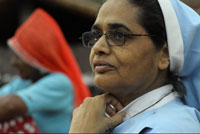Shannon Carroll | Christianity in India | EXPOSURE/Aftermath Workshop in Ajmer

|
|
Audio Slideshow | Posted Nov 13, 2009
Program: Exposure
EXPOSURE/Aftermath Workshop in Ajmer
In Kakaheri, rural India, a woman sits on the floor while she kneads flattened bread with a fire stove in her kitchen. Her husband sits on a chair in the courtyard with their close friend, a Hindu, engaging in intimate conversation while their goats lay in the shade and stalks in their field gently sway.
Kanakheri is a farming village in the Indian state of Rajasthan, surrounded by open fields and cradled by the Aravalli Mountain range. The couple and many of their neighbors are symbolic representations of the religious pluralism between Christians and Hindu. Kanakheri is a Hindu-majority village, and around twenty Christian families live interspersed throughout.
The villagers live in a calm, fully integrated religious environment; the Christian church does not proselytize and appears to have a nominal impact on those who do not seek it out initially. No villagers can recall the church seeking out to convert those who were not Christian, nor dealing with those who don't actively approach the church themselves.
In another part of the village, a woman tends to cows at her husband's family farmhouse, her face covered by her luminescent gold-colored veil. She was born Hindu, yet accepts the Christian god as her husband does. The presence of the Church has had little effect on the interfaith relationships of those within the community, as one villager comments, "we all pray to different gods, but have similarities in morals and faith, no matter which one".
The villagers are fortunate. Across India, many examples of religious discrimination abound. India has been placed on a watch list for "the government's largely inadequate response in protecting its religious minorities" in response to recent communal violence against Christians and Muslims. This action was taken in August 2009 by the US commission on International Religious Freedom.
In 2008, an anti-conversion law, the Religious Freedom Bill, was passed by the Rajasthan Bharatiya Janata Party (BJP) government, reflecting a politicized animosity throughout India by the Hindu right towards minority Christians and Muslims. The BJP, a Hindu nationalist political party, was the incumbent state political faction until the March 2009 elections. The Christian church’s connection with the lower classes has left it a source of friction in the eyes of the BJP. The BJP needs the votes of the tribal communities, and seek to undermine the Christian church to obtain votes and gain power.
The Catholic church is located on the periphery of Kanakheri. On the road to attend church, Christian worshipers peacefully pass by the homes of their friends and extended family, both Christian and Hindu. Before the church was built fifty years ago, worshippers would have to travel to another nearby village, Bhavnikera, to attend church services. Within Kanakheri, the remnants of traditional rural Indian life are pervasive. However, in a slow, quiet manner the village has expanded and developed with the introduction of paved roads, television and satellite installations. A few shops and the area's first private school have been created out of renovated farm buildings, and the number of water wells within the village has increased. These changes align with the improvements the church has brought, from jumpstarting health services to spreading the value of education. According to one villager, "the church brings peace of mind and increases morals of people within the village".
The role and awareness of education has become increasingly prevalent in the lives of younger villagers. Although the majority of elders are illiterate, the first generation of literate-majority villagers are now in their thirties. "I was of the first generation of women in this village to be educated", boasts Sharma, a Christian villager who is age thirty-five. She works as a teacher and her husband is an IT worker at a technology company in a nearby town. Her children, ages eight and twelve, attend a boarding convent school in another region. Her sister who lives in the same house has two daughters, one age five and another one month. Her oldest daughter attends the newly instituted private school in the village, which students can enroll through a process of entrance tests. While preparing for school in the morning, the daughter joyfully identifies words from her school workbook, actively pointing out passages to her family members. Her mother asserts that "when she is older, I want for her to have the possibility to be whatever she wants". "The Christian church prizes education", Sharma says, "if I was not Christian, I'd less likely to have felt the importance to go to school and would have worked in the fields".
An AIDS clinic was built four years ago on the church property. The patients come from all areas in the nearby region. The AIDS clinic acts as a buoy and the only sustaining force in the lives of the patients, who are often incredibly poor have no other resources. The church is indiscriminating, turning a blind eye to the religion of the patients; all are a combination of Christian, Hindu, and Muslim. Although no one is forced, all patients show at the daily prayer meetings to paintings of Jesus Christ and in alter ceremonies.
Although the presence of the church is a boon, the church and the services it provides are only an incremental step in the development of Kanakheri and needs of the villagers who live within. According to Father Anthony Fernandez of Ajmer, "it does not matter if they are Hindu or Christian. The issue is about human rights, and that these people are being helped".

